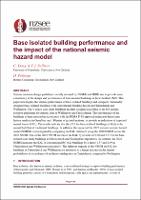| dc.contributor.author | Dong, Siqi (Claire) | |
| dc.contributor.author | Sullivan, Timothy | |
| dc.contributor.author | Pettinga, Didier | |
| dc.date.accessioned | 2023-08-28T04:23:23Z | |
| dc.date.available | 2023-08-28T04:23:23Z | |
| dc.date.issued | 2023-04-19 | |
| dc.identifier.uri | https://repo.nzsee.org.nz/xmlui/handle/nzsee/2567 | |
| dc.description.abstract | The NZSEE/MBIE recently released seismic design guidelines aiming to provide a more consistence design performance of base-isolated buildings in NZ. This paper confirms the superior performance of base-isolated buildings by comparing ‘minimally’ designed base-isolated buildings and conventional buildings. The comparison is also made between isolated buildings designed using ASCE7-22 and NZSEE/MBIE guidelines. Ultimately, this paper aims to identify the factors that affect the performance of base-isolated buildings, including superstructure types, seismic hazard zones, isolator characteristics, and uncertainty in critical non-structural elements. The buildings are designed and modelled for non-linear time history analysis using OpenSees. Their performance is analysed following the performance-based earthquake engineering (PBEE) framework by the Pacific Earthquake Engineering Research (PEER) and is expressed in terms of the annual rate of exceeding damage limit states, the annual rate of exceeding loss ratios, and the expected annual loss. | |
| dc.language.iso | en | |
| dc.publisher | New Zealand Society for Earthquake Engineering | |
| dc.relation.ispartofseries | 2023;98 | |
| dc.subject | Quantifying and addressing uncertainties in seismic design | |
| dc.title | Base isolated building preformance and the impact of the national seismic hazard model | |
| dc.type | Article | |

